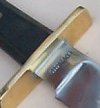DaQo'tah Forge
Banned
- Joined
- Aug 26, 2002
- Messages
- 1,333
Hi this is DaQo'tah
Im now trying to make the brass guard for my 52100 blade, just as Mr. Ed Fowler demonstrates in his Bearing to Blade video.
Well, today is failed miserably in my first attempt at constructing this type of Brass Guard.
In the video Ed Fowler drills the brass out on the drillpress, then uses a file to fit the Tang into place.
I tried,,,but my brass did not fit tight at all,,,I had a gap showing around the guard big enough to slip a fingernail into in places.
The hole for the tang didnt seem to be square to the tang,
In the video Ed bangs the guard into place for a tight fit. I thought i could do that too, but when i would bang on one side, the other end would always pop up.
I never got the brass to slam home against the shoulders of the tang there was always a little gap .
then I tried to solder the brass to the tang...What a disaster!
I think I might have gotten the brass too hot,,,,I used some flux that I had left over from plumbing,,the Radio Shack Silver solder just didnt seem to want to go up as I soldered,,,the solder just puddled on the brass,,,then dripped down onto the vice.
I gave up, and pounded the guard off the tang. On examination, I noticed that solder went up the insides of the guard on only one side of the tang.
QUESTION: - How do I make the hole for the tang in my brass better?
QUESTION; - Lets suppose I mess up my 2nd try at filing the hole in the brass ,and I solder it on anyway, Is there a way to 'Fix' this so that I can end up with a better looking guard?
QUESTION: - Im not sure of the name for the little shoulders that are in front of the guard, but I dont understand how Ed makes his work. Is there a trick Im missing in the video?
Im now trying to make the brass guard for my 52100 blade, just as Mr. Ed Fowler demonstrates in his Bearing to Blade video.
Well, today is failed miserably in my first attempt at constructing this type of Brass Guard.
In the video Ed Fowler drills the brass out on the drillpress, then uses a file to fit the Tang into place.
I tried,,,but my brass did not fit tight at all,,,I had a gap showing around the guard big enough to slip a fingernail into in places.
The hole for the tang didnt seem to be square to the tang,
In the video Ed bangs the guard into place for a tight fit. I thought i could do that too, but when i would bang on one side, the other end would always pop up.
I never got the brass to slam home against the shoulders of the tang there was always a little gap .
then I tried to solder the brass to the tang...What a disaster!
I think I might have gotten the brass too hot,,,,I used some flux that I had left over from plumbing,,the Radio Shack Silver solder just didnt seem to want to go up as I soldered,,,the solder just puddled on the brass,,,then dripped down onto the vice.
I gave up, and pounded the guard off the tang. On examination, I noticed that solder went up the insides of the guard on only one side of the tang.
QUESTION: - How do I make the hole for the tang in my brass better?
QUESTION; - Lets suppose I mess up my 2nd try at filing the hole in the brass ,and I solder it on anyway, Is there a way to 'Fix' this so that I can end up with a better looking guard?
QUESTION: - Im not sure of the name for the little shoulders that are in front of the guard, but I dont understand how Ed makes his work. Is there a trick Im missing in the video?

